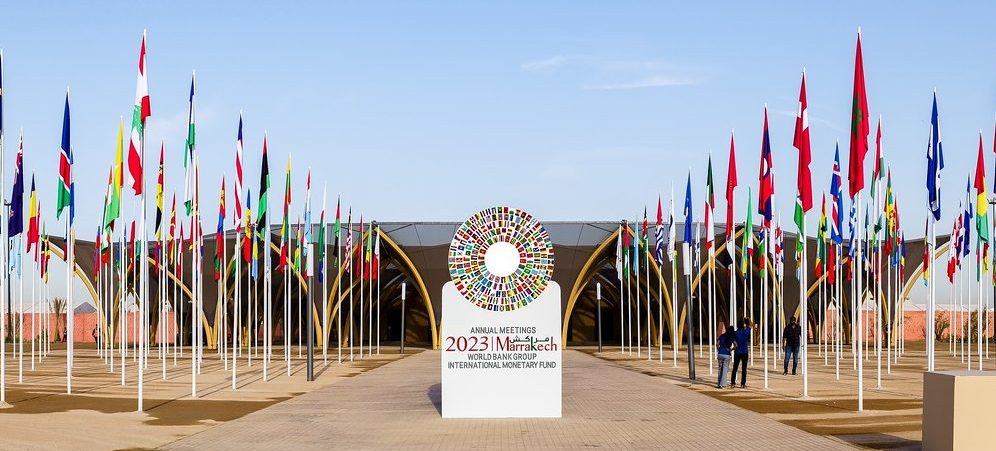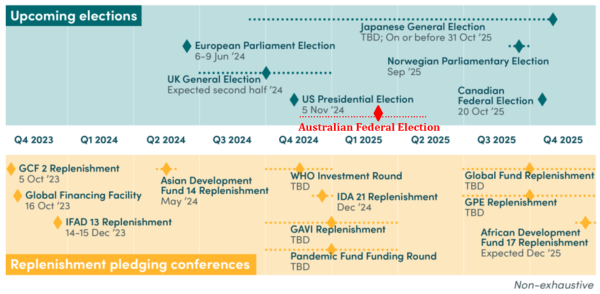This month’s federal budget continued the seemingly inexorable concentration of Australia’s aid spending on its immediate neighbours, particularly in the Pacific and, to a lesser extent, Southeast Asia. In the context of an overall funding envelope that is projected to flatline in real terms over the next decade, this concentration will continue to mean less money for other purposes, including global and multilateral aid.
Multilateral aid helps supply important global public goods in areas like international health and climate change, and advance shared goals like eradicating extreme poverty, advancing gender equality, or alleviating humanitarian suffering. The comparative advantage of multilateral development institutions stems from their ability to pool funds from a range of public and private sources and leverage this in support of greater impact than would be the case if donors went it alone.
According to the most recent data, in proportional terms Australia is one of the smallest contributors of core funding to multilateral development institutions among the OECD’s official donors (Figure 1). Measured as a share of total Official Development Assistance (ODA), the proportion of Australia’s aid provided in the form of “multilateral grants and subscriptions” (that is, non-earmarked or core funding) in 2022 was less than 15%, much lower than the donor average of 33%. Only the US and Japan provided a smaller share – though the sheer size of these two donors means that, in volume terms, their multilateral contributions dwarf Australia’s.

Taken as an average over six years (2016-2022), the proportion is higher – 20% (Figure 2). The volatility reflects that the fact the payment schedules to these organisations vary from year to year. But the overall trend does seem to be one of decline.

And there are external pressures looming. The first is what has been labelled a “traffic jam” of multilateral replenishments over the next couple of years (Figure 3). This includes funding rounds for the concessional financing arms of the big multilateral development banks (MDBs) like the Asian Development Bank’s Asian Development Fund (ADF, which has just finished) and the World Bank’s International Development Association (IDA), as well as replenishments for major global health funds like the Global Fund to Fight HIV/AIDS, Tuberculosis and Malaria, and Gavi, the Vaccine Alliance.
Figure 3: Replenishment pledging conferences and upcoming elections
Adapted from : J Keller, C Landers and N Martinez, The 2024-2025 replenishment traffic jam: are we headed for a pileup?, Center for Global Development, 8 February 2024.
Second, as shown, these funding calls overlap with elections in some of the world’s biggest multilateral players. The US is of particular interest given its role as the largest contributor, in dollar terms, to many of these institutions. A Trump victory in November could see a major US retrenchment on multilateral aid, particularly in areas such as climate change, gender equality, and sexual and reproductive health. This would create pressure on other donors, including Australia, to do more.
Finally, there is the growth in the number of global development funds and institutions themselves. This proliferation reflects the emergence of new development issues and interests, as well as the growing complexity of contemporary global cooperation. In addition to those organisations identified in Figure 3, there is a new climate change Loss and Damage Fund, a new Pandemic Fund, a much-enlarged Coalition for Epidemic Preparedness Innovations, alongside existing specialised UN agencies, funds and programmes like the World Food Programme, World Bank-managed financial intermediary funds like the Global Agriculture and Food Security Program, and dozens more. It is rare that a new multilateral fund replaces an existing one, deepening fragmentation.
Through its Australian Aid Tracker, the Development Policy Centre continues to collect data on Australia’s multilateral commitments, focusing on the MDBs and global health funds. Analysis of this data shows the shifts in Australia’s country contributor rankings over the last two decades across the four bodies mentioned previously – the ADF, IDA, the Global Fund and Gavi.
The results are mixed. In the case of the ADF, Australia has increased and maintained its ranking as a key contributor, moving from the third biggest donor at the 2009-12 replenishment to the second biggest (after Japan) from the 2013-16 replenishment onwards. At the ADF’s 2025-28 replenishment earlier this month Australia cemented this position, increasing its pledge by 16% (to $492 million) on its 2021-24 commitment. Notwithstanding Australia’s growing concern about too many ADB contracts in the Pacific being awarded to Chinese firms, the ADF has the obvious advantage to Canberra of being regionally focused.
The story is very different for IDA, which has a global poverty reduction mandate. Australia has tumbled from being the 11th biggest IDA donor less than a decade ago (2015-17) to 18th in the last two recent replenishments (2021-23 and 2023-25). This has occurred despite increasing poverty in many IDA-eligible countries in the wake of COVID-19 and a growth in the level of IDA resources going to the Pacific.
Australia has also fallen in the donor rankings for the two big global health funds over the last decade, albeit not as dramatically. In the last replenishment (2023-25) for the Global Fund, Australia maintained its position from the previous 2020-22 replenishment as the 11th biggest country donor in terms of pledges. But this is down from its position as the 10th biggest country donor during the three prior replenishments that took place in the 2010s. In the case of Gavi, Australia has fallen from 6th in 2011-15 to 9th in the last two replenishment periods (2016-20 and 2021-25). Australia is, however, one of a small group of donors that has committed funding to Gavi’s pre-commitment financing facility for vaccine purchases.
With these and other agencies seeking new funding, the next two years will be challenging for Australia’s small and stretched multilateral aid allocation. Global health will be a particular pressure point given the big reduction to this sector in the latest budget. Australia’s global health ambassador has recently noted donors’ desire to “move on” after the pandemic — notwithstanding the threat posed by new pathogens — and acknowledged that “aid budgets are stretched from every direction.” A weaker currency could also negatively affect Australia’s multilateral rankings, with contributions to these organisations usually reported in US dollars.
There will be a federal election at some point in the next year. Regardless of what happens in the US, neither major party is likely to go into the campaign promising more funding for multilateral aid. A commitment to a more general, sustained real increase in aid over time would, however, free up more resources for this important (and neglected) part of the budget. To get the best value for its scarce global aid dollar, Australia should also be more transparent about how it allocates this aid, and what impacts are achieved, by publishing its multilateral performance assessments, as it has done previously. Finally, the government should consider a contingency for the aid budget where adverse currency fluctuations undermine Australia’s ability to finance key multilateral commitments in a manner consistent with its size and its development objectives.
Updated data on Australia’s contributions to and rankings for ADF, IDA, the Global Fund can be found on the Commitments section of the Australian Aid Tracker.
Listen to the multilateral aid update on the 2024 aid budget analysis episode of our Devpolicy Talks podcast.





